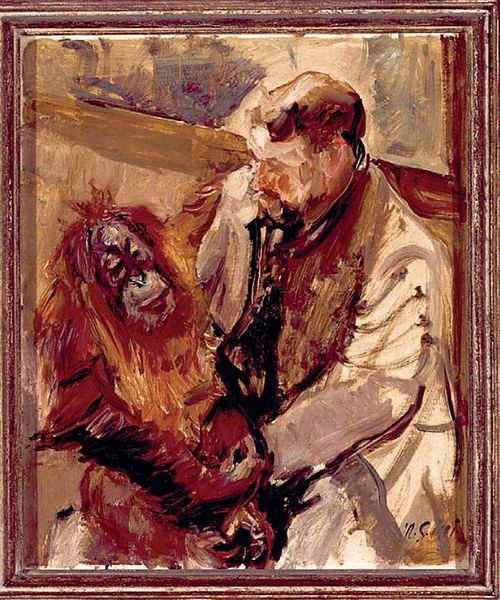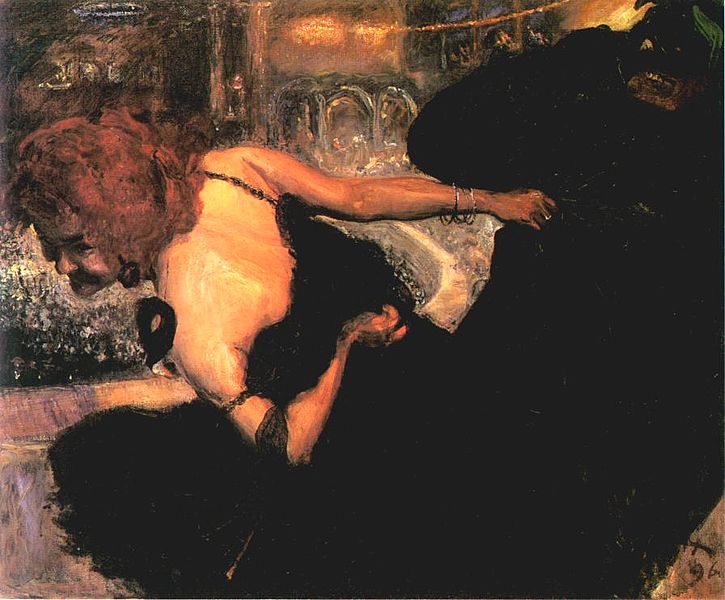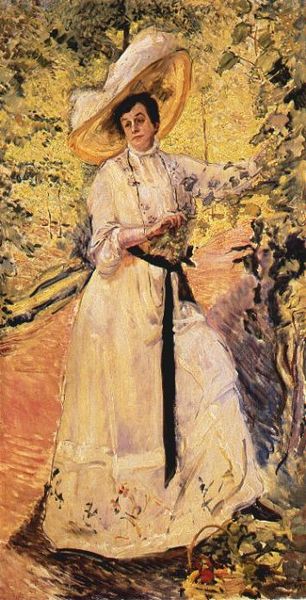<Back to Index>
- Painter and Printmaker Emil Nolde, 1867
- Painter and Illustrator Max Slevogt, 1868
PAGE SPONSOR
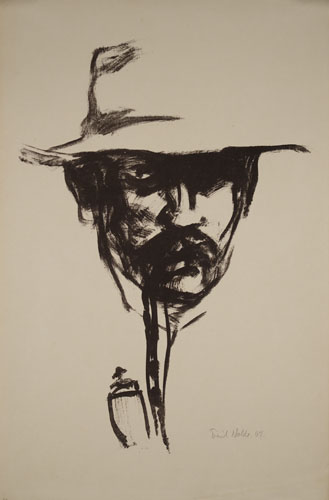
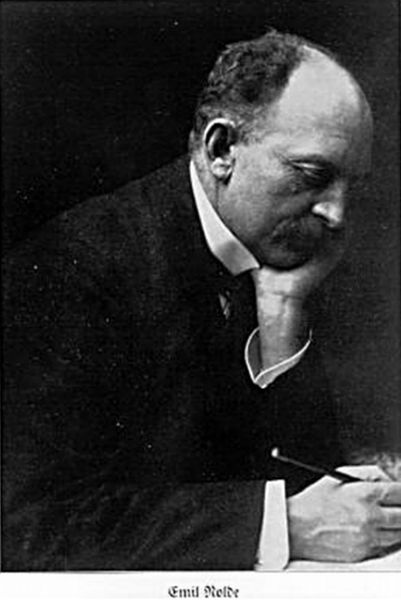
Emil Nolde (7 August 1867 – 13 April 1956) was a German painter and printmaker. He was one of the first Expressionists, a member of Die Brücke, and is considered to be one of the great oil painting and watercolor painters of the 20th century. He is known for his vigorous brushwork and expressive choice of colors. Golden yellows and deep reds appear frequently in his work, giving a luminous quality to otherwise somber tones. His watercolors include vivid, brooding storm scapes and brilliant florals.
Nolde's intense preoccupation with the subject of flowers reflect his continuing interest in the art of Vincent Van Gogh.
Emil Nolde was born as Emil Hansen near the village of Nolde (since 1920 part of the municipality of Burkal in Southern Jutland, Denmark), in the Prussian occupied Duchy of Schleswig. He grew up on a farm; his parents, devout Protestants, were Frisian and Danish peasants. Between 1884 and 1888, he trained as a craftsman and worked in woodcarving, and worked in furniture factories as a young adult. In 1889, he gained entrance into the School of Applied Arts in Karlsruhe before becoming a drawing instructor in Switzerland from 1892 to 1898, eventually leaving this job to finally pursue his dream of becoming an independent artist. As a child he had loved to paint and draw, but he was already 31 by the time he pursued a career as an artist. When he was rejected by the Munich Academy of Fine Arts in 1898, he spent the next three years taking private painting classes, visiting Paris, and becoming familiar with the contemporary impressionist scene that was popular at this time. He married Danish actress Ada Vilstrup in 1902 and moved to Berlin, where he would meet collector Gustav Schiefler and artist Karl Schmidt - Rottluff, both of whom would advocate his work later in life. He spent a brief time between 1906 - 1907 as a member of the revolutionary expressionist group Die Brücke, and as a member of the Berlin Secession in 1908 - 1910, but he eventually left or was expelled from both of these groups – foreshadowing of the difficulty Nolde had maintaining relationships with the organizations to which he belonged. He had achieved some fame by this time and exhibited with Kandinsky’s Der Blaue Reiter group in 1912, supporting himself through his art. From 1902 he called himself after his birthplace.
He realized his unsuitability for farm life and that he and his three brothers were not at all alike. Between 1884 and 1891, he studied to become a carver and illustrator in Flensburg. He spent his years of travel in Munich, Karlsruhe and Berlin. From 1906 to 1907 he was a member of the artist group Die Brücke (The Bridge).
Nolde was a supporter of the Nazi party from the early 1920s, having become a member of its Danish section. He expressed negative opinions about Jewish artists, and considered Expressionism to be a distinctively Germanic style. This view was shared by some other members of the Nazi party, notably Joseph Goebbels and Fritz Hippler.
However Hitler rejected all forms of modernism as "degenerate art", and the Nazi regime officially condemned Nolde's work. Until that time he had been held in great prestige in Germany. 1052 of his works were removed from museums, more than those of any other artist. Some were included in the Degenerate Art exhibition of 1937, despite his protests, including (later) a personal appeal to Nazi gauleiter Baldur von Schirach in Vienna. He was not allowed to paint — even in private — after 1941. Nevertheless, during this period he created hundreds of watercolors, which he hid. He called them the "Unpainted Pictures".
In 1942 Nolde wrote:
There is silver blue, sky blue and thunder blue. Every color holds within it a soul, which makes me happy or repels me, and which acts as a stimulus. To a person who has no art in him, colors are colors, tones tones... and that is all. All their consequences for the human spirit, which range between heaven to hell, just go unnoticed.
After World War II, Nolde was once again honored, receiving the German Order of Merit, West Germany's highest civilian decoration. He died in Seebüll (now part of Neukirchen).
Apart from paintings, Nolde's work includes many prints, often in color and watercolor paintings of various sizes, including landscapes, religious images, flowers, stormy seas and scenes from Berlin nightlife. A famous series of paintings covers the German New Guinea Expedition, visiting the South Seas, Moscow, Siberia, Korea, Japan and China. The Schiefler Catalogue raisonné of his prints describes 231 etchings, 197 woodcuts, 83 lithographs and 4 hectographs.
Nolde's work is exhibited at major museums around the world, including Portrait of a Young Woman and a Child, Portrait of a Man ca. 1926, and Portrait of a Young Girl 1913 - 1914 at the Hermitage Museum, Saint Petersburg, Russia; and Prophet, 1921 and Young Couple 1913 at Museum of Modern Art, New York City. His most important print, The Prophet (1912), is an icon of 20th century art. Unfortunately, the full power of this print comes out only in impressions printed on Japanese paper, which are extremely rare.
No less a virtuoso in oils, he executed Lesende junge Frau (1906), Blumengarten (ohne Figur) (1908) and Blumen und Wolken (1933) which are iconic works in their own right.
Emil Nolde's work has become the focus of renewed attention after a painting entitled Blumengarten (Utenwarf) from 1917, which now hangs in the art museum Moderna Museet, Stockholm, Sweden and has been valued at US$ 4,000,000, was discovered to have been looted from Otto Nathan Deutsch, a German Jewish refugee whose heirs, including a Holocaust survivor, are asking for its return. The Swedish government decided in 2007 that the museum must settle with the heirs. Deutsch was forced to flee Germany before World War II and left for Amsterdam in late 1938 or early 1939. The painting was sold to the Swedish museum at an auction in Switzerland, where it had resurfaced in 1967. Other important works:
- Lesende junge frau, 1906, oil on canvas, Kunsthalle Kiel
- Blumengarten (ohne Figur), 1908, oil on canvas, Sotheby's purchaser 8 February 2012
- Anna Wieds Garten, 1907, oil on canvas, Private Collection
- Steigende Wolken, 1927, oil on canvas, Karl - Ernst - Osthaus - Museum, Hagen
- Grosse Sonnenblumen, 1928, oil on canvas, The Metropolitan Museum of Art, New York
- Blumen und Wolken, 1933, oil on canvas, Museum Sprengel, Hanover
In recent years, Nolde's paintings have achieved prices of several million US dollars, in auctions conducted by the leading international auction houses. On 8 February 2012, Blumengarten (ohne Figur) was sold by Sotheby's in London for the amount of US$ 3,272,673.
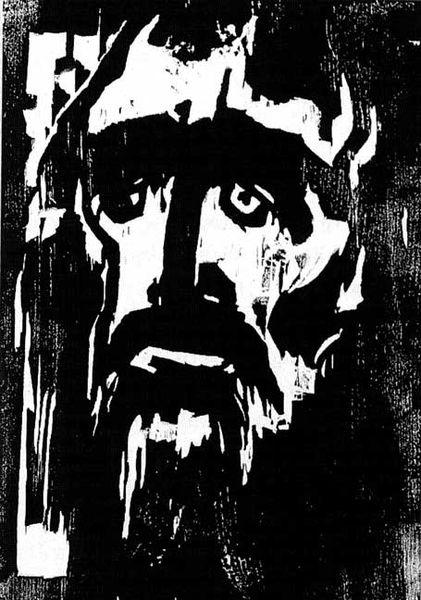
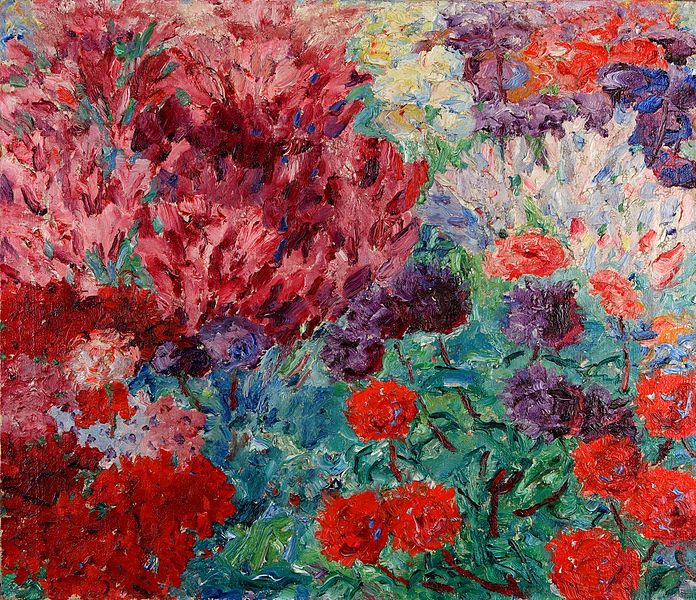
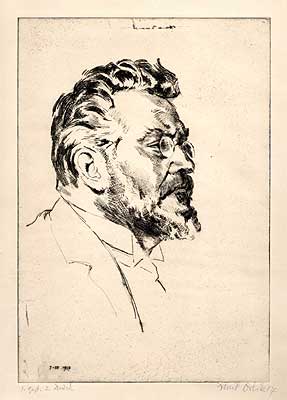
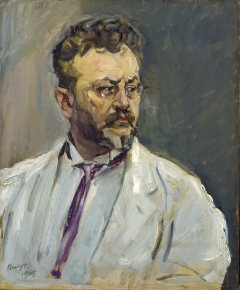
Max Slevogt (October 8, 1868 – September 20, 1932) was a German Impressionist painter and illustrator, best known for his landscapes. He was, together with Lovis Corinth and Max Liebermann, one of the foremost representatives in Germany of the plein air style.
He was born in Landshut, Germany. From 1885 to 1889 he studied at the Munich Academy, and his early paintings are dark in tone, exemplifying the prevailing style in Munich. In 1889 Slevogt visited Paris, where he attended the Académie Julian. In 1896, he drew caricatures for the magazines Simplicissimus and Jugend, and the next year he had his first solo exhibition in Vienna.
Toward the end of the 1890s his palette brightened. He traveled again to Paris in 1900, where he was represented in the German pavilion of the world exhibition with the work Scheherezade, and was greatly impressed by the paintings of Édouard Manet. In 1901 he joined the Berlin Secession.
A trip to Egypt in 1914 resulted in 21 paintings as well as numerous watercolors and drawings; on the return journey he stopped off in Italy. In June he acquired the country seat Neukastel. After the outbreak of World War I he was sent as official war painter to the western front. The war experience brought about a search for new style appropriate to the expression of the horrors of war. In the same year he became a member of the royal academy of the arts in Berlin.
He designed scenery for the performance of Mozart's Don Giovanni in the Dresdner state opera in 1924. In 1929 he was given a large 60th birthday exhibition in the Prussian academy of the arts in Berlin. During the last year of his life he worked on the religious mural Golgatha in the peace church in Ludwigshafen on the Rhine. It was destroyed by bombing raids during World War II.
Max Slevogt died at Leinsweiler (at that time as “Rheinpfalz” part of Bavaria) in 1932. He is buried in the burial place of the family Finkler east of his house, the so called Slevogthof (with wall paintings) at Neukastel.
